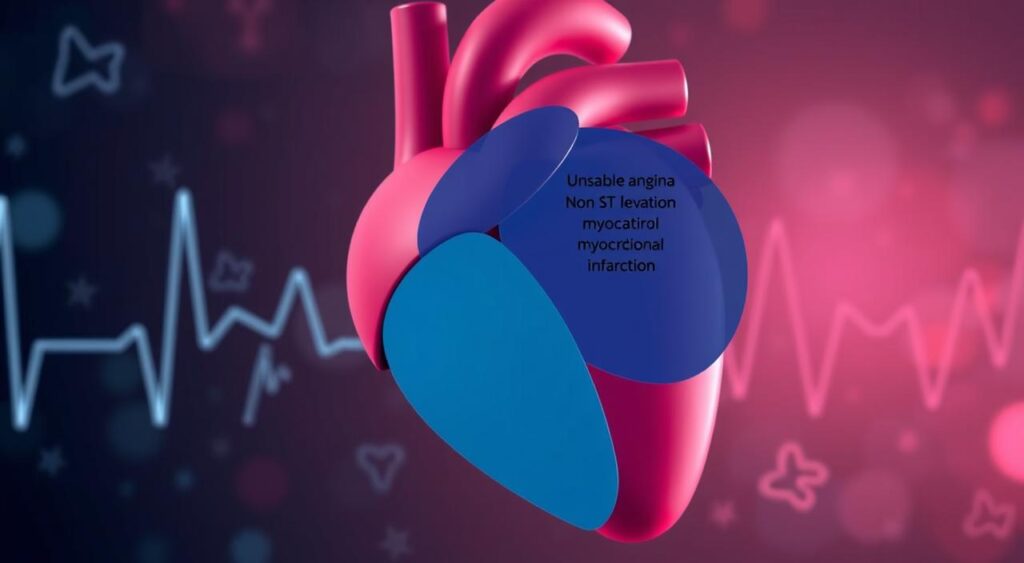Acute coronary syndrome (ACS) is a term for heart conditions caused by reduced blood flow. Unstable angina (UA) and non-ST-elevation myocardial infarction (NSTEMI) are key conditions within ACS. They need quick medical care. This guide will cover UA/NSTEMI, including what they are, their symptoms, risk factors, how they are diagnosed, and the latest treatments.

Key Takeaways
- UA/NSTEMI are acute coronary syndromes that require immediate medical intervention.
- Recognizing the early warning signs and symptoms is crucial for timely diagnosis and treatment.
- Comprehensive diagnostic tests, including cardiac biomarkers and imaging, help differentiate between UA and NSTEMI.
- Prompt medication management, antiplatelet therapy, and coronary interventions are essential for managing UA/NSTEMI.
- Ongoing rehabilitation, lifestyle modifications, and long-term prevention strategies are vital for reducing the risk of future cardiac events.
What is UA/NSTEMI: Definition and Basic Concepts
Unstable angina (UA) and non-ST-elevation myocardial infarction (NSTEMI) are two types of ischemic heart disease. They are part of acute coronary syndrome. Knowing the differences between them is key for correct diagnosis and treatment.
Differentiating Between Unstable Angina and NSTEMI
UA and NSTEMI differ mainly in how much coronary artery disease affects the heart. UA is when blood flow to the heart is reduced, causing chest pain. But, the heart muscle damage is not severe, and heart biomarkers don’t rise much.
NSTEMI, on the other hand, is a more serious heart attack without ST-segment elevation on an ECG. The heart muscle damage is greater, showing up in higher biomarker levels.
The Role of Coronary Artery Disease
Both UA and NSTEMI are tied to coronary artery disease. This disease is when plaque builds up in heart arteries. It can narrow the arteries, cutting off blood and oxygen to the heart.
Pathophysiology Explained
The cause of UA and NSTEMI is the same: plaque in the arteries breaks, causing blood clots. In UA, the blockage is less severe, leading to temporary lack of oxygen without major heart cell death. NSTEMI has a more severe blockage, causing bigger heart damage and biomarker release.
Common Risk Factors and Prevention Strategies
It’s important to know and tackle the risk factors for unstable angina (UA) and non-ST-elevation myocardial infarction (NSTEMI. These are serious heart conditions. Understanding coronary artery disease and the risk stratification process helps people take steps to lower their risk.
Key risk factors for UA/NSTEMI include:
- Getting older
- Having a family history of coronary artery disease
- Diabetes
- Hypertension
- Dyslipidemia
- Smoking
- Being overweight and not active
- Stress and mental health issues
To lower these risks and prevent UA/NSTEMI, people should:
- Stay active and keep a healthy weight
- Eat a balanced diet, low in bad fats and high in fruits, veggies, and whole grains
- Stop smoking and drink less alcohol
- Control conditions like diabetes and hypertension with meds and lifestyle changes
- Focus on stress management and mental health with activities like meditation, yoga, or counseling
- Get regular risk stratification checks and follow doctor advice for prevention plans
By tackling these risk factors, people can lower their chance of ischemic heart disease. This improves their heart health overall.
“The best way to treat a heart attack is to prevent it in the first place.”
– Dr. Mehmet Oz, Cardiothoracic Surgeon
Recognizing Early Warning Signs and Symptoms
It’s key to spot the early signs of unstable angina (UA) and non-ST-elevation myocardial infarction (NSTEMI quickly. This is because some symptoms might not follow the usual patterns. This is especially true for certain groups of people.
Classic vs. Atypical Symptoms
Typical symptoms of UA/NSTEMI include chest pain or discomfort. This pain can spread to the arms, jaw, neck, or back. You might also feel short of breath, sweat, feel nauseous, or dizzy.
But, some people, like the elderly, diabetics, and women, might not show these signs. Instead, they might feel tired, have indigestion, or stomach pain without a clear reason.
When to Seek Emergency Care
If you notice new or worsening chest pain or discomfort, get help right away. Quick action can greatly improve your chances of recovery. It can also lower the risk of serious complications.
Gender-Specific Symptom Variations
Studies show women with UA/NSTEMI often have different symptoms. They might feel short of breath, nauseous, or have back pain more than men. It’s important for doctors and patients to know this. This way, they can get the right treatment fast.
Spotting UA/NSTEMI symptoms early can really help your care. If you’re worried, don’t wait to see a doctor.
Diagnostic Process and Initial Assessment
When a patient shows signs of unstable angina (UA) or non-ST-segment elevation myocardial infarction (NSTEMI), a detailed diagnostic process starts. This process aims to find the cause and decide on the right treatment. It involves several tests and evaluations to help doctors understand the patient’s risk and make the best decisions.
The first step is a physical examination. The doctor checks the patient’s vital signs and looks for heart problems. They also ask for a detailed medical history. Next, an electrocardiogram (ECG) is done. This test shows how the heart is working and helps tell if it’s UA or NSTEMI.
During this time, cardiac biomarkers like troponin levels are checked through blood tests. These biomarkers are key in figuring out how much heart damage there is. Doctors watch how these biomarkers change to help diagnose and treat the patient.
After the initial checks, the healthcare team starts to risk-stratify the patient. This means they figure out how likely it is that the patient will have more heart problems. They use this information to decide if more tests, like coronary angiography, are needed. This test looks closely at the heart’s arteries.
This detailed diagnostic process is important for creating the right treatment plan. It makes sure patients with UA/NSTEMI get the care they need to do well.
“Early and accurate risk stratification is crucial in the management of patients with UA/NSTEMI, as it helps guide the intensity of diagnostic and therapeutic interventions.”
Understanding Cardiac Biomarkers and Their Significance
Cardiac biomarkers are key in diagnosing and managing unstable angina (UA) and non-ST-elevation myocardial infarction (NSTEMI). These markers give insights into the heart’s condition. They help doctors make better decisions during risk assessment.
Troponin Levels and Interpretation
Troponin is a protein in the heart muscle. High troponin levels show heart injury. Doctors watch troponin changes to see how serious the condition is and choose the right treatment.
Other Important Laboratory Tests
Other biomarkers like creatine kinase-MB (CK-MB) and myoglobin also offer important information. Along with clinical findings and ECG results, they help doctors understand the patient’s situation. This leads to a better treatment plan.
Monitoring Timeline and Patterns
Watching how cardiac biomarkers change over time is vital. Doctors check these biomarkers regularly to spot any heart damage. The patterns help decide the best treatment, from medicines to more serious procedures.
| Cardiac Biomarker | Significance | Interpretation |
|---|---|---|
| Troponin | Indicates myocardial injury | Elevated levels suggest NSTEMI, while normal levels may indicate UA |
| CK-MB | Specific to cardiac muscle damage | Elevated levels provide additional evidence of myocardial infarction |
| Myoglobin | Early marker of myocardial injury | Rapid rise and fall can help differentiate between UA and NSTEMI |
Understanding cardiac biomarkers and their patterns helps doctors. They can better assess the risk of UA/NSTEMI patients. This allows for a more tailored treatment approach.
Emergency Treatment Protocols
When a patient is diagnosed with acute coronary syndrome (UA/NSTEMI), quick action is key. The goal is to keep the heart stable and prevent more damage. Every minute counts, as fast treatment can greatly improve the patient’s chances.
The emergency treatment starts with:
- Oxygen therapy: Giving extra oxygen to make sure blood and tissues get enough.
- Pain management: Using medicines like nitroglycerin or morphine to ease chest pain.
- Initial medication administration: Starting antiplatelet therapy to stop platelets from clumping and forming clots.
If the patient’s risk is high, the team might choose urgent revascularization like PCI or CABG. These procedures aim to open blocked heart arteries. This helps reduce damage and boosts the patient’s recovery odds.
| Emergency Treatment Protocols | Key Objectives |
|---|---|
| Oxygen therapy | Ensure adequate oxygenation |
| Pain management | Alleviate chest pain and discomfort |
| Antiplatelet therapy | Inhibit platelet aggregation and prevent further clot formation |
| Urgent revascularization | Restore blood flow to the affected area of the heart |
These emergency steps are vital to stabilize the patient and reduce acute coronary syndrome risks. Quick and effective care can greatly improve the patient’s future and recovery chances.

Medication Options and Management
Managing unstable angina (UA) and non-ST-elevation myocardial infarction (NSTEMI) requires a detailed plan. This plan includes using different medications. These treatments aim to ease symptoms, stop more heart problems, and help patients with ischemic heart disease and acute coronary syndrome.
Antiplatelet Therapy Approaches
Antiplatelet drugs are key in treating UA/NSTEMI. Medications like aspirin, clopidogrel, and ticagrelor stop platelets from clumping. Antiplatelet therapy is a cornerstone of management for patients with these conditions, as it helps to stabilize the plaque and prevent further complications.
Anticoagulation Methods
Anticoagulant medications are also used in UA/NSTEMI treatment. Drugs like heparin, enoxaparin, and fondaparinux stop blood clots from forming. The choice of anticoagulant depends on the patient’s risk factors, the condition’s severity, and the risk of bleeding.
Pain Management Strategies
Relieving chest pain is vital in managing UA/NSTEMI. Nitrates, beta-blockers, and calcium channel blockers can help. Effective pain management not only alleviates patient suffering but also helps to stabilize the condition and prevent further cardiac damage.
It’s crucial for patients to stick to their medication plan and for healthcare professionals to monitor them closely. Patients need to understand the importance of their medications and report any issues to their doctors.
Coronary Angiography and Intervention Procedures
For those with suspected ischemic heart disease, coronary angiography is key. It’s a small procedure that lets doctors see the heart’s arteries. They can check for blockages or narrowing.
This test helps decide the best treatment. It’s also important for planning revascularization procedures.
A thin, flexible catheter is used during the test. It goes through a small cut, usually in the groin or arm. A contrast dye is then injected.
This dye makes the arteries show up on X-ray images. Doctors can see the heart’s arteries clearly. They can spot any ischemic heart disease that needs treatment.
If big blockages are found, doctors might suggest revascularization. This could mean angioplasty or stenting. These methods help open up the artery and improve blood flow.
- Coronary angiography: A diagnostic procedure that uses X-rays and a contrast dye to visualize the coronary arteries.
- Revascularization: A treatment approach that aims to restore blood flow to the heart by addressing blockages in the coronary arteries.
- Angioplasty: A procedure that uses a balloon to widen a narrowed or blocked artery.
- Stenting: The insertion of a small mesh tube to prop open a narrowed artery and improve blood flow.
Understanding coronary angiography and intervention procedures helps doctors. They can make a detailed plan to manage ischemic heart disease. This improves patient outcomes.

Recovery and Rehabilitation Process
Recovering from a UA/NSTEMI event is key to getting your heart health back on track. A good rehab program helps patients get back to their daily lives. It also lowers the risk of ischemic heart disease.
Physical Activity Guidelines
Starting with gentle, guided exercise is important for a strong heart. Cardiac rehab often includes:
- Aerobic exercises, like walking, cycling, or swimming, that start easy and get harder
- Resistance training to build muscle strength and endurance
- Flexibility exercises to keep joints moving and prevent injuries
Lifestyle Modifications
Living a heart-healthy lifestyle is key to avoiding more revascularization and ischemic heart disease. Important changes include:
- Quitting smoking and staying away from secondhand smoke
- Eating a balanced diet with lots of nutrients but less bad fats
- Keeping a healthy weight through diet and exercise
- Managing stress with relaxation, mindfulness, or counseling
Follow-up Care Protocol
Seeing your healthcare provider regularly is vital for checking on your risk stratification. This ensures you’re doing well long-term. This may include:
| Timeframe | Recommended Follow-up |
|---|---|
| 1-2 weeks after discharge | Visit with cardiologist or primary care provider |
| 3-6 months after discharge | Comprehensive evaluation, including stress testing or imaging studies |
| Annually | Regular check-ups and risk assessment |
By joining in the recovery and rehab, patients can greatly improve their future health and life quality after a UA/NSTEMI event.
Long-term Prevention and Management Strategies
Managing unstable angina (UA) and non-ST-segment elevation myocardial infarction (NSTEMI) goes beyond the first treatment. Keeping the heart healthy for the long term needs a mix of ongoing risk checks, lifestyle changes, and sticking to medication.
It’s key for those with ischemic heart disease or coronary artery disease to get regular check-ups. These include stress tests, cardiac imaging, and lab work. They help doctors see if a patient’s condition is changing and adjust treatment plans as needed.
- Changing your lifestyle to eat healthy, exercise regularly, and quit smoking can lower your risk of heart problems.
- It’s important to take your medications as directed. Antiplatelet drugs, anticoagulants, and other heart medicines help manage risk stratification and prevent serious issues.
Patients who stick to their treatment plans and keep in touch with their doctors are more likely to stay stable and avoid future heart problems.
| Strategy | Description | Potential Benefits |
|---|---|---|
| Continuous Risk Monitoring | Regular check-ups, stress tests, and cardiac imaging to assess changes in cardiovascular health | Early detection of worsening conditions, timely adjustments to treatment plans |
| Lifestyle Modifications | Healthy diet, regular exercise, smoking cessation, stress management | Reduced risk of future cardiovascular events, improved overall well-being |
| Medication Adherence | Consistent use of prescribed antiplatelet therapies, anticoagulants, and other cardiovascular medications | Effective management of ischemic heart disease, prevention of complications |
By focusing on long-term prevention and management, patients with UA or NSTEMI can greatly improve their heart health. This reduces the chance of future heart problems.
Conclusion
As we wrap up our look at UA/NSTEMI, a serious heart condition, it’s clear that quick action is key. These heart diseases can show up in many ways, from chest pain to less common signs. This makes it vital to know the different symptoms, especially for men and women.
Diagnosing UA/NSTEMI involves tests like cardiac biomarkers and imaging. These tools help doctors decide the best course of action. From emergency care to long-term plans, a full approach is needed to tackle UA/NSTEMI’s challenges. Keeping up with new heart care research helps everyone stay focused on heart health.
We hope this article has given you a better grasp of UA/NSTEMI. It should help you spot warning signs, get help fast, and take care of your heart. By focusing on prevention, early action, and overall care, we can all help improve outcomes for those with UA/NSTEMI and other heart diseases.
FAQ
Q: What is the difference between unstable angina and NSTEMI?
A: Unstable angina and NSTEMI are both serious heart issues. Unstable angina causes chest pain at rest or with little effort. NSTEMI is when a coronary artery partially blocks, causing heart injury and releasing biomarkers like troponin.
Q: What are the common risk factors for UA/NSTEMI?
A: Risk factors for UA/NSTEMI include heart disease history, diabetes, and high blood pressure. Other risks are high cholesterol, smoking, obesity, and being older. A family history of heart disease and a sedentary lifestyle also increase risk.
Q: What are the typical symptoms of UA/NSTEMI?
A: Symptoms of UA/NSTEMI include chest pain or discomfort. It feels like a heavy, squeezing sensation. Some people might feel short of breath, tired, nauseous, or have pain in the arms or jaw. If you experience these, get medical help right away.
Q: How are cardiac biomarkers used in the diagnosis of UA/NSTEMI?
A: Cardiac biomarkers, especially troponin, are key in diagnosing UA/NSTEMI. High troponin levels show heart injury, helping tell NSTEMI from unstable angina. Doctors use these biomarkers to decide on treatment.
Q: What are the immediate treatment options for patients with UA/NSTEMI?
A: First steps for UA/NSTEMI include oxygen, pain relief, and antiplatelet drugs like aspirin. Urgent angiography and procedures like PCI or CABG might be needed to fix the heart.
Q: What is the role of medications in the long-term management of UA/NSTEMI?
A: Long-term, UA/NSTEMI patients take antiplatelet drugs, anticoagulants, and other medications. These help prevent future heart problems and improve health. Taking these medicines as directed is key to managing UA/NSTEMI.
Q: How important is the recovery and rehabilitation process for patients with UA/NSTEMI?
A: Recovery and rehab are crucial for UA/NSTEMI patients. It includes getting more active, making lifestyle changes, and joining cardiac rehab. These steps improve heart health and quality of life.
